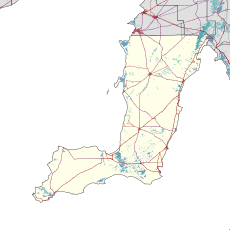Port Victoria, South Australia facts for kids
Quick facts for kids Port VictoriaSouth Australia |
|||||||||||||||
|---|---|---|---|---|---|---|---|---|---|---|---|---|---|---|---|

Main street looking towards Spencer Gulf
|
|||||||||||||||
| Postcode(s) | 5573 | ||||||||||||||
| Elevation | 3 m (10 ft) | ||||||||||||||
| Location | |||||||||||||||
| LGA(s) | Yorke Peninsula Council | ||||||||||||||
| State electorate(s) | Narungga | ||||||||||||||
| Federal Division(s) | Grey | ||||||||||||||
|
|||||||||||||||
Port Victoria (once called Wauraltee) is a small town. It sits on the west coast of the Yorke Peninsula in South Australia.
Like many towns along this coast, Port Victoria has a jetty. It used to be a very busy port. Ships would load grain here to send all the way to England. The nearby Wardang Island helps protect the port from strong westerly winds.
Contents
A Port for Sailing Ships
Port Victoria was famous for its large sailing ships. These ships were called windjammers. They carried huge amounts of bagged grain. These big ships would stop in England or Ireland. There they would get orders on where to deliver the grain.
The Last Windjammer Port
Smaller coastal boats, like ketches and schooners, visited many ports. But Port Victoria was special. It had a deep anchorage for the very large windjammers. The grain was first loaded onto ketches at the jetty. Then, these ketches would carry the grain out to the bigger windjammers.
The busiest time for these sailing ships was the 1930s. This period was known as the Great Grain Race. The last working sailing ships visited in 1949. Because of this, Port Victoria is known as the last of the windjammer ports. You can learn more about this history at the Port Victoria Maritime Museum.
The town was originally named Wauraltee. It was officially renamed Port Victoria in 1940.
Port Victoria Today
Today, Port Victoria is mostly a fishing town. It becomes very lively during the holiday season. Many people visit to enjoy the coast and fishing.
Port Victoria in Books
Port Victoria has appeared in some interesting books. These stories help us imagine what the town was like.
The Last Grain Race
In 1939, an English writer named Eric Newby visited Port Victoria. He was working as a crew member on a huge four-masted barque called the Moshulu. The sailors on the Moshulu often called Port Victoria "Port Veek." It was their second stop in Australia.
Newby wrote about his experiences in his book, The Last Grain Race (1956). He didn't always say nice things about the town. But he did say the people were "kind and hospitable." The Moshulu stayed anchored off Port Victoria for over a month. During that time, 4,875 tons of grain were loaded. That's about 59,000 bags! Each bag was loaded by hand onto ketches at the jetty. Then, they were ferried out to the Moshulu and loaded into its holds.
Other famous sailing ships also loaded grain at Port Victoria in 1939. These included the Olivebank, Pamir, Pommern, and Viking. Some streets in Port Victoria are now named after these ships. Newby's book includes pictures of Port Victoria from 1939.
Young Adult Novels
Port Victoria is also the setting for two popular Young Adult novels. These books were written by Phillip Gwynne. His classic novel Deadly, Unna? was published in 1998. Its sequel, Nukkin Ya, came out in 2000. These books are enjoyed by many young readers.


